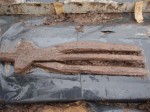2009년도 북서부 잉글랜드 에단강 인근의 고속도로 건설현장에서 발견된 신석기시대 목기가 출토되었다. 이목기의 기능에 대해서는 무기인지 농기구인지는 확실치 않지만 신석기시대 출토된 가장 완벽한 목기(삼지창)의 형태를 가지고 있다.
Two large Neolithic wood tridents of unknown purpose have gone on display in the Tullie House Museum’s Border GalleryThe artifacts were donated to the Carlisle museum, which is currently also hosting the spectacular Crosby-Garret Helmet, by the Cumbria County Council which owned the land on which they were found. The museum is delighted by the donation as it would have been hard pressed to afford them on the open market.
 The tridents were discovered in 2009 during an archaeological survey in advance of the construction of the Carlisle Northern Development Route. They found such an incredible bonanza of Neolithic and Mesolithic artifacts that the excavation intended to last three mounts wound up taking three years to complete. Mesolithic flints alone were found in staggering numbers: 1,500 buckets of earth were sieved every week, a total of 270,000 liters of soil, in which around 314,000 stone pieces were discovered, including used tools and waste flakes. The site, an island between two paleochannels, was a major production center for stone tools in the late Mesolithic.
The tridents were discovered in 2009 during an archaeological survey in advance of the construction of the Carlisle Northern Development Route. They found such an incredible bonanza of Neolithic and Mesolithic artifacts that the excavation intended to last three mounts wound up taking three years to complete. Mesolithic flints alone were found in staggering numbers: 1,500 buckets of earth were sieved every week, a total of 270,000 liters of soil, in which around 314,000 stone pieces were discovered, including used tools and waste flakes. The site, an island between two paleochannels, was a major production center for stone tools in the late Mesolithic.
 Its location in the flood plain of the River Eden also saw to the preservation of organic materials, thanks to the archaeologists’ best friend (because of how it preserves perishable remains) and worst enemy (because of the painful digging conditions requiring constant pumping and rubber trousers): waterlogged soil. Among many wooden artifacts retrieved from the watery pit were the two tridents. Carved out of a single piece of mature oak (the three was approximately 300 years old when felled), the tridents are two meters (six feet) long and have three straight-sided tines, although one tine is broken off on the most complete example and two tines are missing altogether on the other.
Its location in the flood plain of the River Eden also saw to the preservation of organic materials, thanks to the archaeologists’ best friend (because of how it preserves perishable remains) and worst enemy (because of the painful digging conditions requiring constant pumping and rubber trousers): waterlogged soil. Among many wooden artifacts retrieved from the watery pit were the two tridents. Carved out of a single piece of mature oak (the three was approximately 300 years old when felled), the tridents are two meters (six feet) long and have three straight-sided tines, although one tine is broken off on the most complete example and two tines are missing altogether on the other.
 Radiocarbon dating of the sapwood at the outer edges of the trident revealed they date to between 3,900 and 3,300 B.C. Whoever carved those tridents from a mature hardwood only had stone tools to do the job. They must have been extremely difficult pieces to craft. Judging from the placement of the complete trident — the broken tine was carefully tucked beneath it — they weren’t simply discarded.
Radiocarbon dating of the sapwood at the outer edges of the trident revealed they date to between 3,900 and 3,300 B.C. Whoever carved those tridents from a mature hardwood only had stone tools to do the job. They must have been extremely difficult pieces to craft. Judging from the placement of the complete trident — the broken tine was carefully tucked beneath it — they weren’t simply discarded.
Unlike modern pitchforks, where the tines split from the haft is a horizontal step of sorts which adds to the mystery of what these tridents were used for. They were too heavy and blunt for use as fishing spears or digging forks. The tines could have been wrapped in skins and used as paddles, but this too is a far from ideal design for the task. Also, there’s also no evidence of use, no wear patterns, no chips or gouges.
 There are only six of these rare pieces known to exist, and the other four were all discovered in the 19th century, two in Cumbria after the draining of Ehenside Tarn in the 19th century (find published in 1873), the other two in a peat bog in County Armargh, Ireland (published in 1857). Now that two more have been found in Cumbria again, archaeologists are wondering if there was some trade or cultural link between the Neolithic Cumbrians and the people in Neolithic Northern Ireland.
There are only six of these rare pieces known to exist, and the other four were all discovered in the 19th century, two in Cumbria after the draining of Ehenside Tarn in the 19th century (find published in 1873), the other two in a peat bog in County Armargh, Ireland (published in 1857). Now that two more have been found in Cumbria again, archaeologists are wondering if there was some trade or cultural link between the Neolithic Cumbrians and the people in Neolithic Northern Ireland.
Andrew Mackay, Head of Collections & Programming at Tullie House said: “These tridents are so rare that they of national importance so it is a great thrill to have them available to show to the visitors of Tullie House. We are very keen to canvass opinion on what they might be so I’d like to encourage everyone to come and see them and let us know what they think.”
For more about the excavation and to browse tons of pictures of the finds, see Oxford Archaeology North’s fantastic website about the project.
'고고학 뉴스' 카테고리의 다른 글
| 네안데르탈인 유전자, 당뇨병 가능성 ↑ (0) | 2013.12.26 |
|---|---|
| 동아시아인 다수가 네안데르탈인 게놈 보유 (0) | 2013.12.20 |
| 빙하가 녹아 발견된 5400년전의 신석기시대 활과 화살 (0) | 2013.11.30 |
| 인류 진화 보여준 180만 년 전 두개골 (0) | 2013.10.18 |
| 인류 최초의 화가는 여성이었다 (0) | 2013.10.16 |




